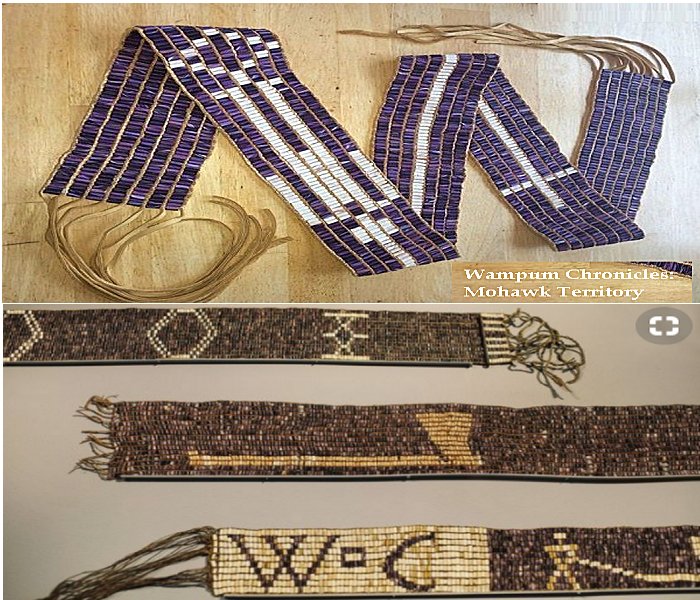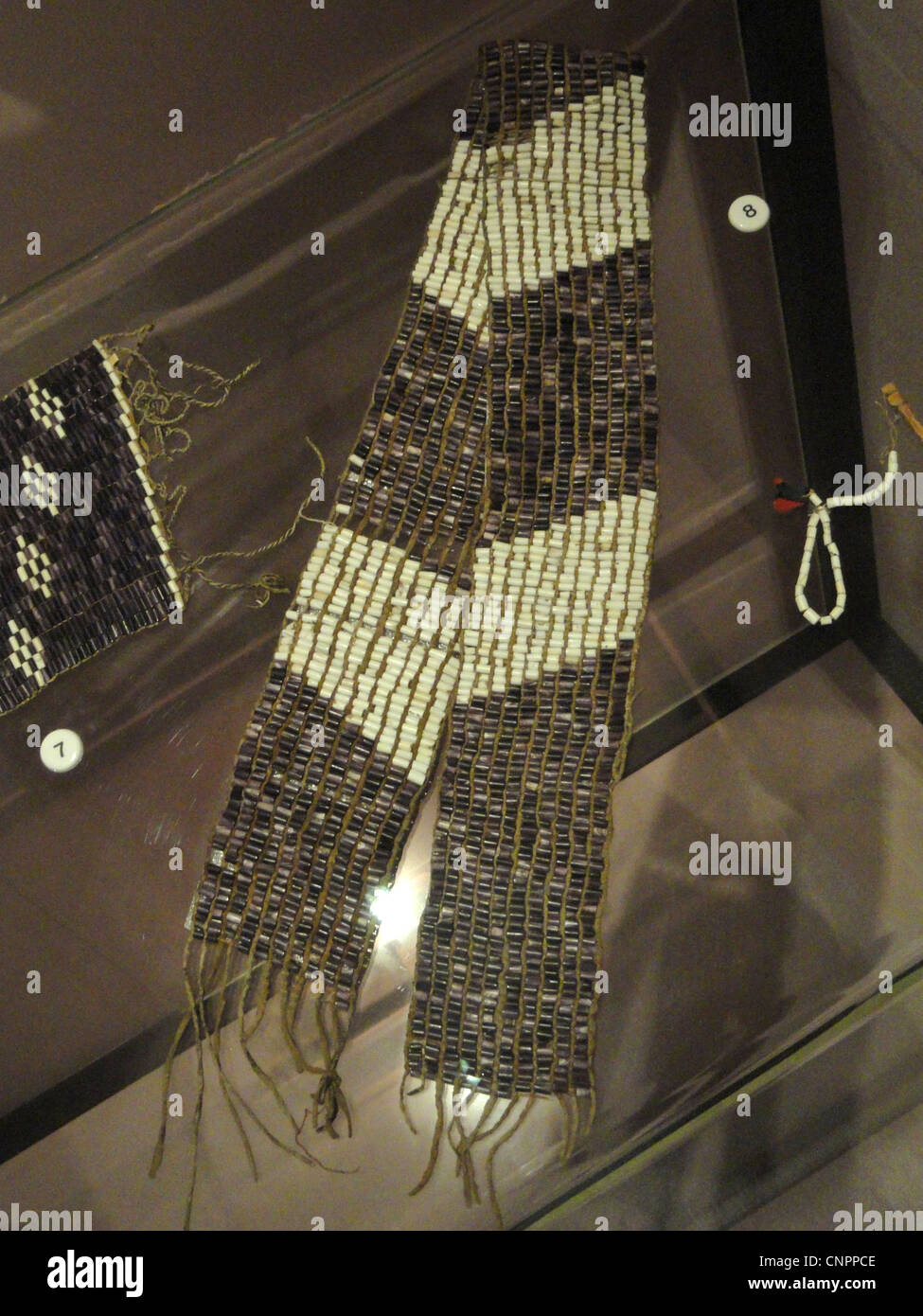
The Enduring Legacy of Wampum Belts: A Deep Dive into Native American Collections, Diplomacy, and Cultural Memory
Wampum belts, often misunderstood as mere decorative artifacts or primitive currency, represent one of the most sophisticated and enduring forms of cultural expression, historical record-keeping, and diplomatic protocol among various Indigenous nations of Northeastern North America. Far from simple beads, these intricately woven shell belts are living documents, imbued with profound spiritual, political, and social significance. This article delves into the origins, construction, diverse functions, historical context, and modern relevance of wampum belts, exploring their place within Native American collections and the ongoing efforts to understand and reclaim their invaluable cultural patrimony.
I. Origins and Material Culture: The Sacred Shells
The very essence of wampum lies in its raw materials: specific marine shells. The two primary types of beads are crafted from the Atlantic hard-shell clam ( Mercenaria mercenaria ), commonly known as the quahog, which yields the distinctive purple or "black" beads, and the whelk shell (genus Busycon or Sinistrofulgur ), providing the pure white beads.
The creation of wampum beads was an arduous and highly skilled process. Indigenous artisans, particularly those of the Narragansett, Wampanoag, and Pequot nations, meticulously broke, ground, drilled, and polished these dense shells into small, cylindrical beads, typically ranging from a quarter to a half-inch in length. The drilling of a precise hole through the center of each bead, often without metal tools in pre-contact times, was a testament to incredible patience and craftsmanship. This labor-intensive production inherently endowed wampum with immense value, not merely as a commodity, but as an object reflecting dedicated human effort and the sacredness of the natural world.

The colors of wampum held intrinsic symbolic meaning. White beads often represented peace, purity, light, truth, and spiritual well-being. Purple (or black) beads, on the other hand, frequently symbolized serious matters, sorrow, war, or matters of significant political or spiritual import, often carrying a deeper weight or authority. The interplay of these colors within a belt created a visual language, each pattern and combination conveying a specific message or narrative.
II. Construction and Craftsmanship: Weaving Histories and Futures
Wampum beads were initially used as individual ornaments, strung into necklaces, earrings, or incorporated into clothing. However, their evolution into woven belts marked a pivotal development, transforming them into complex mnemonic devices and official records. The weaving process itself was precise, involving sinew, plant fibers, or later, linen threads, which were used to string the beads into rows. These rows were then secured by additional weft threads, creating a sturdy and cohesive fabric-like belt.
The patterns within wampum belts were not arbitrary. They ranged from simple geometric designs—lines, squares, diamonds—to more complex representational figures such as human stick figures, trees, longhouses, or canoes. Each pattern, combined with the color scheme, served as a "visual text" or mnemonic cue. When a wampum belt was presented, a designated "wampum keeper" would "read" the belt, reciting the historical event, treaty terms, or spiritual message embedded within its design. This act was not mere recitation; it was a performance that reinforced collective memory and reaffirmed the living connection between the past and the present.
III. Functions and Significance: More Than Just Beads
The true depth of wampum belts lies in their multifaceted functions, which spanned diplomatic, historical, spiritual, and social spheres:
A. Diplomatic Instruments and Treaties
Perhaps the most renowned function of wampum belts was their role in diplomacy and treaty-making, particularly among the Haudenosaunee (Iroquois) Confederacy, but also among the Lenape, Anishinaabe, and other Northeastern nations. Wampum belts were essential for:
- Validating Agreements: A treaty or alliance was not considered binding until sealed by the exchange of wampum belts. These belts served as physical proof of the agreement, symbolizing the gravity and sincerity of the parties involved.
- Recording Treaty Terms: The patterns on the belts often represented key clauses or principles of a treaty. A famous example is the Two Row Wampum (Guswenta), a foundational Haudenosaunee treaty. It consists of two parallel rows of purple beads on a white background, symbolizing two distinct vessels—a Native canoe and a European ship—traveling side-by-side down the river of life. The three white rows between them represent peace, friendship, and respect. It signifies an agreement to coexist without interfering in each other’s laws, customs, or spiritual beliefs.
- Facilitating Communication: In formal council meetings, wampum was used to open and close sessions, to present proposals, or to authenticate the words of a speaker. To "send a string of wampum" meant to send an official message.

B. Historical Records and Oral Tradition
Wampum belts were critical to the preservation of Indigenous history and law within societies that relied primarily on oral tradition. They served as:
- Mnemonic Devices: Rather than literal written texts, wampum belts acted as powerful memory aids, triggering detailed oral narratives of laws, prophecies, historical events, and ancestral teachings.
- Archives of Collective Memory: Entire historical epochs, significant decisions, and the lineage of leaders could be encapsulated within a series of belts, passed down through generations of wampum keepers. The Hiawatha Belt, for instance, represents the founding of the Haudenosaunee Confederacy, with five central figures symbolizing the unity of the original five nations.
C. Spiritual and Ceremonial Objects
Wampum also held profound spiritual significance:
- Sacred Authority: The act of speaking with or presenting wampum was a sacred act, elevating the gravity of the words spoken. It was believed to possess spiritual power that ensured truthfulness.
- Condolence and Healing: In Haudenosaunee condolence ceremonies, specific wampum strings and belts were used to "wipe the tears" and "clear the throats" of mourners, restoring balance and peace after the loss of a leader.
- Ritual Objects: Wampum was incorporated into various rites of passage, spiritual practices, and ceremonial gatherings, symbolizing connections to the spirit world and ancestral wisdom.
D. Social and Political Authority
Beyond diplomacy, wampum marked social standing and political office:
- Badges of Office: Leaders and chiefs often wore or carried wampum as symbols of their authority, responsibility, and the trust placed in them by their people.
- Exchange in Social Transactions: Wampum was exchanged in marriage negotiations, as gifts, and to mark significant social commitments, affirming relationships and obligations.
It is crucial to differentiate Indigenous use of wampum from its later, European-imposed role as currency. While European colonizers often attempted to repurpose wampum as a standardized medium of exchange for trade goods, its primary and most profound Indigenous function was never simply monetary. Its value derived from its symbolic power, the labor involved in its creation, and the sacred agreements it represented.
IV. Wampum in Collections: History and Controversies
The history of wampum belts in collections is intertwined with the complex and often fraught relationship between Indigenous nations and colonial powers.
A. Colonial Acquisition and Displacement
During the colonial era, many wampum belts were acquired by Europeans through various means:
- Diplomatic Exchange: Some were legitimately given as part of treaty agreements, though their meaning was often misunderstood or undervalued by European recipients.
- Forced Sales and Theft: As Indigenous power waned, many belts were coerced from communities, seized as spoils of war, or simply stolen.
- Missionary Influence: Some belts were acquired by missionaries who sought to suppress Indigenous spiritual practices, viewing wampum as "pagan" objects.
These acquisitions led to the dispersal of countless belts from their original communities, often ending up in private collections, historical societies, and eventually major museums around the world.
B. Major Institutional Holdings
Today, significant collections of historical wampum belts are housed in prominent institutions globally. In the United States, the New York State Museum, the Smithsonian National Museum of the American Indian, and the Peabody Museum of Archaeology and Ethnology at Harvard University hold important collections. Internationally, institutions like the British Museum and the Musée du Quai Branly in Paris also possess wampum belts, testaments to their global reach through colonial encounters.
These collections are invaluable for research and preservation, allowing scholars and Indigenous communities to study the artistry and historical context of these objects. However, their presence in institutional hands often represents a profound cultural loss for the communities from which they originated.
C. Repatriation and Cultural Patrimony
The late 20th and early 21st centuries have seen a significant movement towards the repatriation of wampum belts and other sacred objects to their rightful Indigenous custodians. The Native American Graves Protection and Repatriation Act (NAGPRA) in the United States, enacted in 1990, has been a crucial legal framework facilitating the return of human remains, funerary objects, sacred objects, and objects of cultural patrimony.
The repatriation of wampum belts is not merely about ownership; it is about the restoration of cultural memory, spiritual practice, and community identity. For Indigenous nations, these belts are not inert museum artifacts but living entities that hold the spirits of their ancestors and the history of their people. Their return allows communities to re-engage with their traditions, revive ceremonial practices, and pass on ancestral knowledge to new generations. While repatriation efforts have seen successes, challenges remain, including establishing clear provenance, managing competing claims from different nations, and ensuring appropriate storage and care for these sensitive objects.
V. Modern Relevance and Revitalization
Despite centuries of colonial disruption, wampum belts continue to be a vibrant and living part of Indigenous cultures. New wampum is being created, and traditional weaving techniques are being revitalized. Contemporary Indigenous artists and artisans are crafting new belts and strings, not just as reproductions, but as expressions of ongoing cultural resilience, political statements, and affirmations of identity.
Indigenous nations continue to use historical and newly created wampum in ceremonies, council meetings, and educational initiatives. They serve as powerful teaching tools, connecting youth to their heritage and fostering a deeper understanding of their ancestors’ diplomatic and spiritual wisdom. Wampum belts stand as enduring symbols of sovereignty, mutual respect, and the unbroken chain of Indigenous history and identity.
Conclusion
Wampum belts are far more than aesthetically pleasing artifacts; they are complex repositories of Indigenous knowledge, diplomacy, spirituality, and history. From the laborious crafting of sacred shells to their intricate weaving into mnemonic devices, these belts served as the bedrock of political alliances, the archives of collective memory, and the conduits of spiritual truth for numerous Northeastern Native American nations. Their journey from the hands of their creators to colonial collections and, increasingly, back to their communities, reflects a larger narrative of cultural resilience, reclamation, and the ongoing quest for justice and recognition. As objects of profound cultural patrimony, wampum belts continue to speak, reminding us of the sophisticated societies that created them and the enduring power of their messages for present and future generations. Their study offers invaluable insights into Indigenous epistemologies and serves as a powerful call for respectful engagement with the living heritage of Native American peoples.


